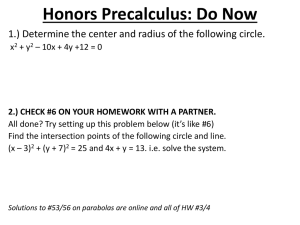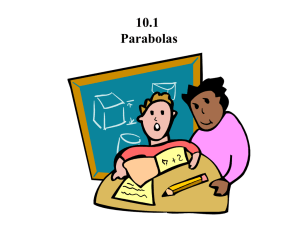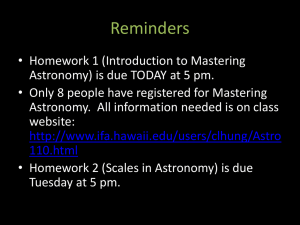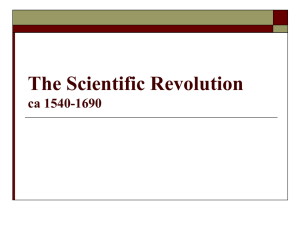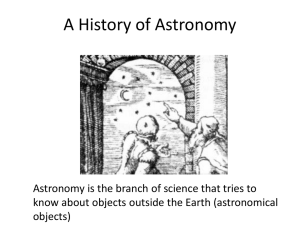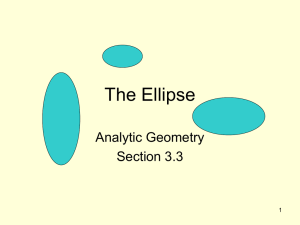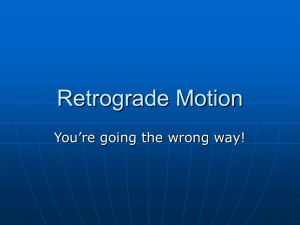Astronomy History
advertisement
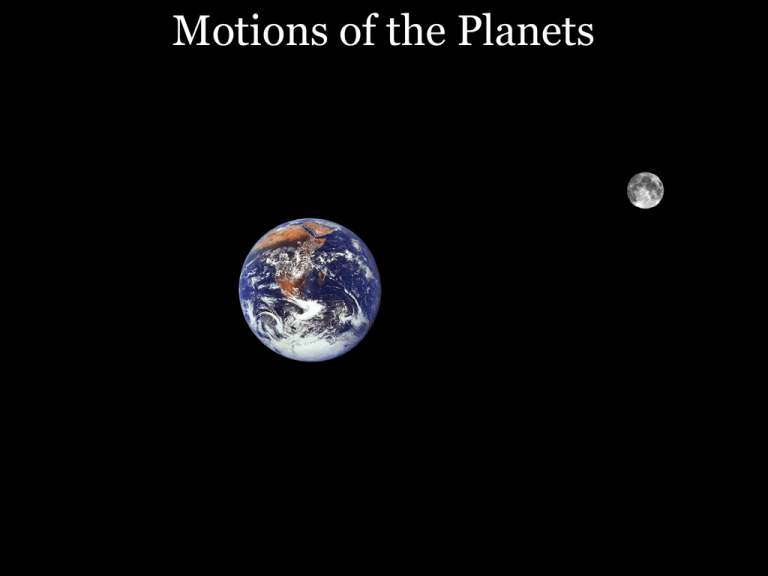
Motions of the Planets This presentation will introduce these terms: Geocentric, Heliocentric, Retrograde, Rotation, Revolution. The Celestial Sphere The ancient astronomers believed that the Universe was made up of spheres (orbs). The sphere that contained all of the objects seen in space was the Celestial Sphere. The sphere rotated around the earth making it appear as if all celestial objects were revolving around the earth. In this image you can see the stars and the Sun look as if they’re attached to the sphere Where is the person in the image trying to get to? The Geocentric Model of the Universe Historically, the ancient Greek astronomer Ptolemy (87 to around 170 AD) made many observations of the motions of the Sun, Moon, and planets. Watch both movies. Describe the observations made by Ptolemy and other ancient astronomers that caused them to come up with this geocentric model. Based on his observations Ptolemy designed a Geocentric model of the universe. Based on his observations, he placed all the planets, stars, Sun, and Moon on separate spheres with the earth placed at the center. Click the Green “Play” button in the animation to see Ptolemy’s idea in action. What do you suppose might’ve been a problem with this model? See then next slide for the answer. Click here to learn more about the Geocentric Model Epicycle The movie explains how Ptolemy saw the universe and how he explained the motions of the planets. Mars’ Orbit Start with the movie player at the upper left. This will give you an idea of the problem Ptolemy had with his geocentric idea. The “problem” is illustrated in the lower left and his solution for this problem is shown in the upper right. Ptolemy used “epicycles” to solve the problem of explaining retrograde motion but these epicycles were cumbersome and really not natural though his geocentric model was the model of choice for centuries. Why do you suppose people chose to believe this model rather than a Sun-centered model? This animation shows the retrograde motion of Mars over several months. The image to the right shows Mars’ retrograde path. What causes this retrograde motion of the planets? Development of The Heliocentric Model of the Universe Watch this short movie. More than a millennia after Ptolemy proposed his geocentric idea, what did Brahe observe that radically changed the view of the Universe? Based on his observation, how did his model differ from the very popular Ptolemy model? Tycho Brahe. Copernicus and the Heliocentric Model Click here to learn more about the Heliocentric Model How did the Copernicus model differ from the Brahe and Ptolemy models? Geocentricvs. vs. Heliocentric Geocentric Heliocentric Both models were riddled with mistakes. The major problems were: Geocentric – could not explain retrograde motion. Heliocentric – circular orbits were not consistent with the changing apparent diameter of Mars and the Sun (this apparent changing diameter of the sun was a problem really with both ideas). See next slide for demo Definitions of Perihelion and Aphelion This slide shows the sun on two different days of the year. Each day is 6 months apart (January 3 and July 4). What do you notice about the Sun’s diameter from January to July? What would cause the sun to appear to change its diameter cyclically over the course of each year? Could the planets be orbiting the sun in a perfect circle or was it some other shape? See the next slide to learn who was responsible for this new radical way of thinking. Be sure you check out the definitions of these two new words. (http://epod.usra.edu/archive/images/animated.gif) Along Comes Kepler Johannes Kepler Kepler’s Geometry of Orbits designed by Johannes Kepler early1600 1. LAW OF ORBITS: Planets orbits are in the shape of an ellipse with the sun at one foci. See next slide for demonstration. Earth’s orbit An Ellipse L X X F2 F1 The Sun See next slide for demo Law of Orbits Comprehensive Diagram Not drawn to scale. F = Foci L = Major Axis L X X This diagram shows the Earth in orbit around the Sun. Notice the distance from the Sun at both perihelion and aphelion. Is it the same or different? F2 F1 Notice the placement of the Sun with respect to the other focus point and the earth’s orbital path.. The Sun is place at one of the two focus points (foci = plural). The Foci are fix points used to create the ellipse. How many foci are needed to create a perfect circle? What is the difference between a circle and an ellipse? What are Foci? What’s the Major Axis? Eccentricity = a measurement of the “flatness” of an ellipse. What’s a Circle? What’s an Ellipse? Eccentricity of Orbits • Determine the eccentricity of the following ellipse. F1 and F2 are the foci and the dotted line is the major axis. • Measure the distance between the foci and divide that by the length of the major axis to determine an ellipse’s eccentricity (e). • Look at the ellipses on the slide. F1 What F2 happens to the eccentricity of an ellipse (value of e) when you move the foci further apart? Closer together? • When calculating eccentricity (e), what do you call an ellipse that has an eccentricity of 1.0? What about 0.0? • Can an ellipse be more elliptical than 1.0? Less elliptical than 0.0? • What do you think the eccentricity of a straight line (completely flattened out ellipse) is? What about the eccentricity of a perfect circle? F1 F2 Earth Science Reference Tables Solar System Data (page 15) • Using your ESRT Solar System Data (page 15) determine, if any, relationships between a planet’s mean distance from the Sun and the planet’s eccentricity. • Which planet has the most eccentric (flattened out) ellipse? Which planet has the least eccentric ellipse? • Is Earth’s orbital eccentricity closer to that of a perfect circle or a straight line? • HINT!!! – round all the eccentricities to the nearest tenth!! Eccentricity of Orbits • Look carefully at this chart. What can you determine from the data regarding the eccentricities of the planets. • Try to answer the same questions from the previous slide by using this chart. • You can now begin Lab 8-3 • Watch the movie to get an idea of how to do this lab. • Doing this lab notice the differences in eccentricity when you create your ellipses and change your foci. • How does the eccentricity change as the ellipse gets more flattened? • How does the eccentricity change as the ellipse gets less flattened?
